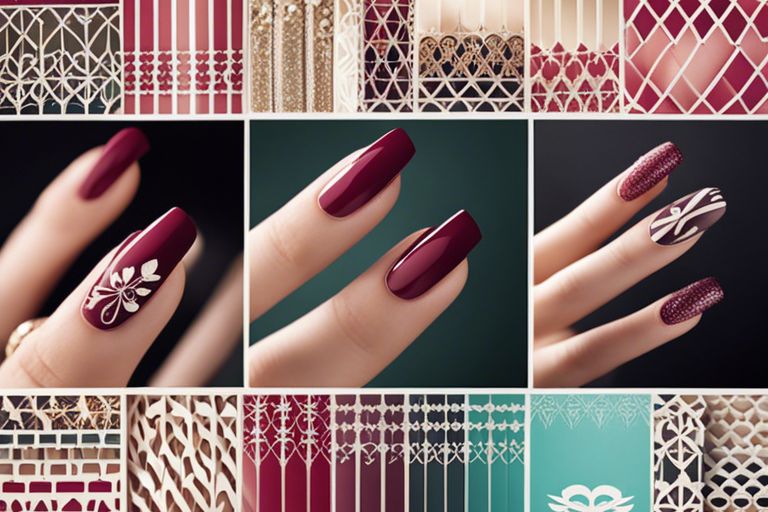Over the years, nail extensions have become increasingly popular as a way to enhance the look of your nails. Whether you’re looking to add length, strength, or simply a bit of flair, nail extensions can be the perfect solution for achieving the manicure of your dreams. In this guide, we will cover everything you need to know about nail extensions, from the different types available to the maintenance required to keep them looking their best. So sit back, relax, and get ready to learn all about the world of nail extensions!
What are Nail Extensions?
Before delving into the world of nail extensions, it’s imperative to understand what they are and how they can enhance the appearance of your nails. Nail extensions are artificial enhancements applied to your natural nails to extend their length and create a desired shape. They can be a great option if you struggle to grow your nails long or if you want to try different nail shapes without waiting for your natural nails to catch up.
Definition and Purpose
Definition: Nail extensions refer to artificial tips or overlays that are applied to your natural nails to create length and enhance the appearance of your nails. The primary goal of nail extensions is to provide you with the desired length and shape that your natural nails may not be able to achieve on their own.
Types of Nail Extensions
Types of Nail Extensions: Concerning nail extensions, there are various options to choose from, each offering unique benefits and effects. Some common types of nail extensions include acrylic, gel, fiberglass, silk, and dip powder. Each type has its own application method and durability, so it’s imperative to choose the one that best suits your preferences and lifestyle.
- Acrylic: Known for their durability and strength.
- Gel: Offer a more natural look and flexibility.
- Fiberglass: Provide a lightweight and natural appearance.
- Silk: Ideal for strengthening natural nails and repairing damaged nails.
- Dip Powder: A long-lasting option that requires no UV light for curing.
Knowing the differences between these types can help you make an informed decision when choosing the right nail extensions for you.
| Nail Extension Type | Description |
|---|---|
| Acrylic | Durable and strong. |
| Gel | Natural look and flexibility. |
| Fiberglass | Lightweight and natural appearance. |
| Silk | Strengthens natural nails and repairs damaged nails. |
| Dip Powder | Long-lasting option that doesn’t require UV light curing. |
Purpose
Purpose: The main purpose of nail extensions is to enhance the appearance of your nails by providing length and strength where your natural nails may fall short. Whether you want to achieve a specific nail shape, add extra durability to your nails, or simply enhance their overall look, nail extensions can help you achieve your desired nail goals.
Benefits of Nail Extensions
Aesthetic Appeal
Extensions can give your nails a polished and elegant look that lasts longer than regular polish. Whether you prefer a natural appearance or want to experiment with bold colors and designs, nail extensions offer endless possibilities to enhance the beauty of your hands.
Confidence Boost
Benefits of nail extensions go beyond aesthetics; they can also be a significant confidence booster. Having well-maintained nails can make you feel more put together and ready to take on the day. With nail extensions, you can feel more self-assured in social settings and professional environments.
Confidence is key to making a lasting impression, and having beautifully manicured nails can be the perfect finishing touch to your overall style. When you feel good about your appearance, it shows in your demeanor and interactions with others.
Versatility
Nail extensions offer versatility in terms of length, shape, and design. Whether you prefer short and natural nails or long and glamorous ones, extensions can help you achieve the look you desire. Additionally, you can experiment with different nail art trends and embellishments to express your personal style.
Versatility is one of the most appealing aspects of nail extensions. You can switch up your nail look as frequently as you like, making it easy to adapt to various occasions and moods. From classic French tips to trendy geometric designs, the possibilities are endless with nail extensions.
Pre-Extension Preparation
After deciding to get nail extensions, there are a few important steps you should take to ensure the best results. Start by establishing a nail care routine to keep your natural nails healthy and strong.
Nail Care Routine
Any nail technician will tell you that a consistent nail care routine is crucial for maintaining the health of your natural nails, especially when getting extensions. Make sure to keep your nails clean, well-trimmed, and moisturized. Use cuticle oil regularly and avoid using your nails as tools to prevent breakage.
Choosing the Right Nail Technician
Technician selection is necessary when it comes to nail extensions. You want to find a skilled and experienced technician who prioritizes the health of your natural nails. Look for someone who uses high-quality products and practices proper sanitation procedures.
This is crucial because a poorly trained technician or subpar products can damage your natural nails and lead to infections. Take the time to research and read reviews to find the right nail technician for you.
Consultation and Communication
One of the most important aspects of the pre-extension process is the consultation with your chosen nail technician. During this time, you can discuss your desired nail look, any concerns you may have, and ask any questions about the extension process.
Right communication with your technician is key to ensuring you get the nail extensions you want while also maintaining the health of your natural nails. Be open about your preferences, any allergies you may have, and follow any aftercare instructions provided by your technician.
The Extension Process
Despite being a popular choice for enhancing the beauty of your nails, getting nail extensions can be a daunting process if you’re unfamiliar with it. Understanding the extension process can help you feel more comfortable and confident during your nail appointment.
Application Methods
Methods of applying nail extensions vary, with some technicians using tips or forms to create the desired length. Tips are pre-made plastic nail extensions that are glued to the tip of your natural nail, while forms are placed under the edge of your natural nail to create a base for the extension material.
Materials Used
One common material used for nail extensions is acrylic. Acrylic extensions are durable and can be easily shaped to your desired length and style. They are created by mixing a powder (polymer) with a liquid (monomer) to form a putty-like substance that hardens when exposed to air.
It’s imperative to discuss with your nail technician the type of material that will suit your lifestyle and preferences best. Gel extensions, another popular choice, are made from a gel substance that is cured under a UV or LED lamp. This type of extension is preferred for its natural-looking finish and flexibility.
Aftercare Instructions
Materials used for nail extensions require special care to ensure their longevity. After getting nail extensions, it’s crucial to avoid activities that could put stress on your nails, such as opening cans or using your nails as tools. Additionally, regularly moisturizing your cuticles and nails can help maintain the health of your natural nails.
For instance, wearing gloves while doing household chores or gardening can prevent lifting or breakage of the extensions. Trimming your nails regularly and avoiding harsh chemicals when cleaning can also contribute to the durability of your nail extensions.
Common Concerns and Risks
Damage to Natural Nails
Risks of getting nail extensions include potential damage to your natural nails. The process of applying and removing extensions may weaken your nails over time, making them prone to breakage and thinning. It’s necessary to give your natural nails time to breathe and recover in between extension applications to prevent long-term damage.
Infection and Sanitation
Concerns about nail extensions also include the risk of infection and inadequate sanitation practices at nail salons. Poorly sanitized tools or improperly trained technicians can lead to bacterial or fungal infections. To minimize these risks, make sure the salon you visit follows proper sanitation protocols, uses clean tools, and prioritizes hygiene.
The health of your nails is crucial, so always ensure that your technician is trained and that the salon maintains high cleanliness standards. If you notice any signs of infection, such as redness, swelling, or pain around your nails, seek medical attention promptly.
Cost and Maintenance
The cost and maintenance of nail extensions can be a concern for many. While initial application can be pricey, the ongoing upkeep, such as refills and repairs, can add up over time. Additionally, you may need to adjust your lifestyle to prevent damage and maintain the longevity of your extensions.
The investment in nail extensions involves not only monetary costs but also time for maintenance and care. Before getting extensions, consider your budget and schedule to ensure you can commit to the upkeep required for beautiful and healthy nails.
Caring for Your Nail Extensions
Daily Maintenance
With your new nail extensions, daily maintenance is necessary to ensure they stay looking their best. Remember to be gentle with your nails, avoiding tasks that may cause unnecessary strain or damage. It’s crucial to keep your nail extensions clean and dry to prevent any bacteria from accumulating underneath them. Regularly moisturize the cuticles and the skin around your nails to maintain the health of your natural nails and the extensions.
Refills and Repairs
With nail extensions, refills are necessary every 2-3 weeks to keep your nails looking fresh and to maintain their strength. During a refill appointment, your technician will fill in the gap between your cuticles and the existing nail extension to ensure a seamless look. If you experience any lifting or damage to your nail extensions, it’s crucial to get them repaired promptly to prevent further issues.
To keep your nail extensions in top condition, it’s recommended to avoid using your nails as tools for picking, opening items, or any other task that may put undue pressure on them. By being mindful of how you use your hands, you can prolong the lifespan of your nail extensions.
Removal Process
One important aspect of caring for your nail extensions is knowing when it’s time to remove them. While it may be tempting to try and remove them yourself, it’s best to visit a professional nail technician to ensure they are safely and correctly removed. Improper removal can damage your natural nails, so it’s necessary to leave this task to the experts.
Understanding the proper care and maintenance of your nail extensions is crucial to ensure they look great and your natural nails stay healthy. By following these tips and staying vigilant with your nail care routine, you can enjoy beautiful and long-lasting nail extensions.
Final Words
With these considerations in mind, you now have a comprehensive understanding of nail extensions. From the various types available to the process of application and maintenance, you are equipped with all the necessary knowledge to make informed decisions when it comes to enhancing your nails. Remember to prioritize the health of your natural nails and seek professional help when needed to ensure the best results.
Whether you are looking to add length, strength, or style to your nails, nail extensions can be a great option. By following the tips and guidelines outlined in this article, you can achieve the beautiful and long-lasting results you desire. Now go ahead and experiment with different styles and designs to express your creativity through your newly extended nails!



